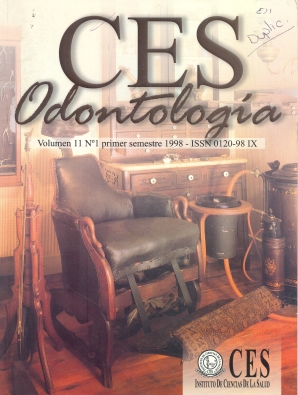ESTADO DE SALUD BUCAL DE NIÑOS PREESCOLARES DE NIVEL SOCIOECONÓMICO ALTO y MEDIO-ALTO. MEDELLÍN,1997
Resumen
practicas de las madres de 241 niños preescolares(1-5 años) de estrato socioeconómico alto y medio-alto, matriculados en 4 jardines infantiles de Medellín. Se realizó un estudio descriptivo con técnicas sugerida de recolección, examen clínico bucal y encuesta autoaplicada a las madres o encargados del cuidado del niño. Se encontró baja prevalencia de caries, 15% para estrato medio-alto y 12 % para estrato alto. El índice ceo es 0,57 en el medio-alto y 0,33 en el alto. La conservación dentaría es muy buena con solo 2 dientes perdidos por caries del total examinado.EI índice gingival de 0,27 (alto) y 0,43 (medio-alto), revela una gingivitis leve en la mayoría de los examinados. Los hábitos de succión digital, chupo y biberón tienen baja prevalencia, lo que ha contribuido con el buen estado de la dentición y evitara problemas esqueléticos posteriores. En cuanto a la higiene oral, el 94,7% del medio-alto, la inician antes del segundo año y el 63,3% del alto, después de este año. En el estrato medio-alto el 27,5% de los niños se dispensan la crema ellos mismos y en el alto lo hacen un 16,7%. De estos niños según las madres, las 2/3 partes se tragan la crema dental. El 60% de los niños ha asistido al odontólogo y un 41,3%(alto) y 66%(medio-alto) lo han hecho antes del primer año. Las madres tienen alto nivel de escolaridad, pero pasan mas de cuatro horas fuera de casa, dejando los niños al cuidado de la abuela o empleada, por lo cual se sugieren programas educativos no solo a las madres, sino a otras personas que tienen responsabilidad en su cuidado. En general se puede concluir que, para el grupo de preescolares evaluados según los resultados existe un buen estado de salud oral y que el nivel socioeconómico influye notablemente en el. ABSTRACT The purpose of the present study was to describe and compare the state of oral health knowledge and practices by the mothers of 241 preschool children (1-5 years) of high and mid-high socioeconomic status, who attended 4 nursery school institutions in Medellin. A descriptive study was conducted with the following data collection techniques: oral clinical examinations and self-adminisered surverys to mothers or people in charge of the children. A low prevalence of caries was found, 15% for the mid-high status and the 12% for the high status. The ceo of 0,57 (mid-high) and 0,33 (high). Tooth conservation was good, with only 2 teeth lost due to caries out of the total sample of children examined. A Gingival index of 0,27 (high) and 0,43 (mid-high) revealed a mild gingivitis in most children examined. Habits (thums sucking, pacifer) and buttle fedding had a low prevalence, and thus contribuited to the good oral healt of their dentition . With regards to oral hygiene, 94,7% in the mid-high status begin before two years of age, and 63,3% in the high status, after two years. In the mid-higih status 27,5% of the children dispense their toothpaste by themselves, and ind the high status 16,7% do the same. According to their mothers, two thirds of these children swallow the toothpaste. Sixty percent of the children have been to the denstist, and 41,3% (high), and 66% (mid-high) have done so before their first year of age. Their mothers have a high level of schooling, but they spend more than 4 hours a day away from home, leaving thier children under the care of the children's grand-mothers of maids. Therefore, educatuional programs are suggestted, not only for mothers, but also for other people who participate in the children's care. It can be concluded that the group of preschool children assesed present a good oral health state, and thath the socioeconomic state has a significant influence.Descargas
Los datos de descargas todavía no están disponibles.
Descargas
Publicado
2009-11-18
Cómo citar
1.
Bustamante Rpo Z, Camargo Cruz L, Correa Zuluaga P, Hernández MS, Macias M, Franco Cortés Ángela M. ESTADO DE SALUD BUCAL DE NIÑOS PREESCOLARES DE NIVEL SOCIOECONÓMICO ALTO y MEDIO-ALTO. MEDELLÍN,1997. CES odontol. [Internet]. 18 de noviembre de 2009 [citado 27 de julio de 2024];11(1):35-8. Disponible en: https://revistas.ces.edu.co/index.php/odontologia/article/view/841
Número
Sección
Artículo de Investigación Científica y Tecnológica
| Estadísticas de artículo | |
|---|---|
| Vistas de resúmenes | |
| Vistas de PDF | |
| Descargas de PDF | |
| Vistas de HTML | |
| Otras vistas | |



